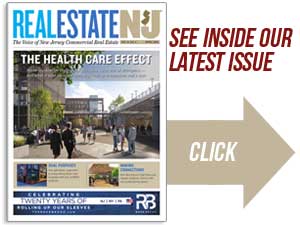The waterfront Riverton project in Sayreville is slated to create a 6.5 million-square-foot mixed-use development with about 1.3 million square feet of retail and entertainment space, 2 million square feet of office and other commercial space and some 2,000 residential units, which includes 300 affordable housing units.
By Joshua Burd
State officials are set to consider a 10-year, $400 million tax credit award that would help advance the massive but long-delayed redevelopment of the former National Lead property in Sayreville, where plans call for 6.5 million square feet of development across a mix of uses.
Planning for the $2.5 billion project, which would revitalize a 400-acre brownfield site along the Raritan River, has quietly moved ahead in recent years since being taken over by North American Properties in 2018. The development entity is now listed on the agenda for the EDA’s board meeting today, having applied for the tax credit under the state’s Aspire program in connection with the project’s residential components.
Additional details were not immediately clear, but the full scope of what’s known as Riverton would include some 2,000 residential units, 300 of which would be reserved as affordable housing. Other segments include some 1 million square feet of retail, restaurant and entertainment space, including the largest single-level Bass Pro Shop in the country that is slated to break ground in the coming months, along with a waterfront promenade, hotel rooms with conference facilities and a mix of professional, creative and medical office space.
The site, which includes two miles of waterfront property, has caught the eye of developers for more than two decades, with its access to the region and a location alongside 24 lanes of traffic on the Garden State Parkway and routes 9 and 35. Cincinnati-based NAP revealed in late 2017 that it was taking over the project in hopes of transforming the formerly contaminated site that was once home to a sprawling paint pigment manufacturing complex.
Sayreville’s planning board has granted preliminary and final major site plan approval for the first phase of the project, which includes Bass Pro Shops and a series of so-called Gateway Services buildings, according to MyCentralJersey.com. NAP, meantime, has largely completed the remediation while preparing the infrastructure for vertical development.
Today’s EDA agenda lists an applicant known as Sayreville Seaport Associates Urban Renewal LP, which is seeking an Aspire tax credit allocation for “a phased transformative residential project.” The award would cover up to 50 percent of qualifying costs under the program.
EDA officials have noted with past approvals that Aspire, which was created by the New Jersey Economic Recovery Act of 2020, is a place-based economic development program to support mixed-use, transit-oriented development with tax credits to commercial and residential projects that have financing gaps. All residential Aspire projects must include at least 20 percent affordable housing, while applicants must certify that all commitments established at time of approval have been met before receiving their first disbursement of tax credits.
Applicants under Aspire are eligible to receive a percentage of the project’s eligible costs, subject to a cap that is determined by its location, other financing available and other aspects of the plan. The EDA recently updated the rules for the program to account for the spike in inflation and other rising costs, resulting in higher per-project caps that included changes to the “transformative project” category, in which proposals must demonstrate special economic importance to New Jersey and leverage the state’s mass transit assets, higher education assets and other economic development assets to attract or retain employers and skilled workers or in targeted industries by providing employment or housing.
The site of what will become Riverton recently drew a visit from a host of public officials, as the state Department of Environmental Protection announced the relaunch of its Brownfield Development Area Program. The agency touted the near completion of remediation for the largest and most complex redevelopment project in New Jersey history, following a more than $120 million cleanup effort, including $20 million in Hazardous Discharge Site Remediation Funds that helped leverage $100 million in private sector funding.










